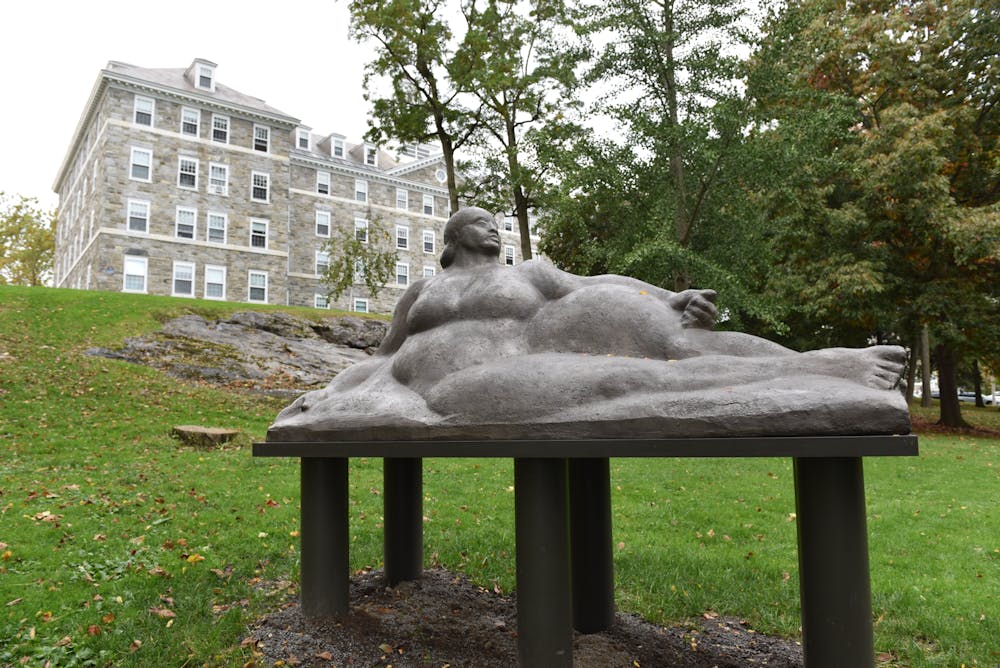Anyone who has walked down the hill by the chapel recently may have noticed a new addition to the landscape. In the shadows of the tree grove lies a sculpture of a figure — one that is difficult to interpret from afar. A number of students have expressed confusion over exactly what the statue depicts and how it came to be displayed outside Gifford Hall. Upon a closer look, as the bronze cast glimmers in the sun on a nice day, a plaque reveals the work’s name: “La Montagne,” French for “The Mountain,” by Parisian-sculptor Gaston Lachaise.
Originally created in 1919, “La Montagne” is a clay sculpture of the artist’s wife and muse, Isabel Dutaud Nagle Lachaise. The version of “La Montagne” on campus is a replica of the clay original.
Local contractors and excavators worked with the Middlebury College Committee on Art in Public Places to install the sculpture in the ground on Aug. 3.
From the planning to installation stages, getting “La Montagne” fully in place took a little over a year, according to Ken Pohlman, museum designer at the Middlebury College Museum of Art. Pohlman and Thatcher Littlefield, assistant registrar at the museum, are in charge of the installation and maintenance of the Committee on Art in Public Places’ exhibits, which include Patrick Villiers Farrow’s “Frisbee Dog” outside of Forest Hall and Tony Smith’s “Smog” outside of BiHall.
Pohlman and Littlefield collaborated with the Committee on Art in Public Places and the Lachaise Foundation to bring “La Montagne” to Middlebury this past summer. Established in 1963, the Lachaise Foundation is a charitable trust founded under Isabel Lachaise’s will with the goal of perpetuating Gaston Lachaise’s artistic legacy.
“The foundation serves to protect, promote and perpetuate the legacy of the artist for the public benefit,” Lachaise Foundation Director Paula Hornbostel told The Campus. One way the foundation pursues this mission is by working with colleges like Middlebury, as well as with public parks and museums, to display Lachaise’s pieces through a process of gifts and loans.
The process begins with Hornbostel reaching out to the organization of interest, which in this case was Middlebury College, about the possibility of having a piece of art on loan to the college. The Committee on Art in Public Places deliberated for many months, Pohlman said, about whether the “La Montagne” piece was the right piece for the college’s art collection. Clearly, the committee eventually decided that the sculpture would be a nice addition to the Middlebury artistic landscape, and the sculpture will remain on display on campus for the next five to ten years.
Before the finished version of “La Montagne” was installed, it had to be transformed from clay, which is generally an artform that erodes easily, into bronze with silver patina finish, a material more fit for harsh Middlebury winters. This process began with the creation of a rubber mold from the original clay sculpture covered in plaster. The piece was then recreated by the Modern Art Foundry in Queens, NY., the same foundry that was used by Lachaise himself in the early 20th century.
In order to understand Lachaise’s art, it is important to understand his inspiration. Throughout his life, Lachaise attributed his artistic creativity to his wife, Isabel, and this admiration for women is reflected in “La Montagne.”
“I think it is important for people to understand the story of Lachaise in order to understand the sculpture, because he just worshiped his wife, and held women in general on a very high pedestal,” Hornbostel said.
Lachaise spoke of his inspirations for “La Montagne,” and his art-work more generally, saying, “In Paris, I met a young American person who immediately became the primary inspiration which awakened my vision and the leading influence that had directed my forces. Throughout my career as an artist, I refer to this person by the word 'Woman.'”
Lachaise aimed to sculpt women as he saw them: full of power, strength and beauty, according to Hornbostel.
“He was capturing the essence of women that he respected,” Hornbostel said.
Lachaise made a number of versions of “La Montagne,” from the original completed in 1919 to the replica currently at Middlebury, and others in between. According to the Metropolitan Museum of Art website, “Lachaise emphasized the correspondence between the rotund figure of a reclining woman and the ‘fertile rolling pastures, broad and soft as fecund breasts’ found in the natural landscape.” Lachaise’s depiction of nude women was considered groundbreaking for the early 20th-century and many art history scholars regard Lachaise as a pioneer of early American Modernism.
Hornbostel added that while the placement of “La Montagne” may seem odd to some, its location is very intentional. “The original was made for the forest, and it was supposed to emerge as you came upon it,” Hornbostel explained. The location of “La Montagne” among the trees outside Gifford Hall arguably achieved this goal, as Hornbostel described witnessing many surprised students stop in their tracks the first time they saw the sculpture.
Pohlman echoed her sentiment, adding that they adopted the base of the sculpture to be a silver patina that matches the gray limestone of Gifford Hall behind it, so that the two appear to flow into one another. “We actually modified the base to something that was a bit lower and more intimate,” he said. Tucked away in the shelter of the trees, yet facing towards the Green Mountains, “La Montagne” is a testament to the significance of placement and staging in expressing artistic meaning.
Pohlman acknowledged the possibility of backlash against this type of piece. “The idea of putting a nude woman sculpture on campus can cause some concern or negative press,” he said.
Still, Pohlman stressed that the Committee on Art in Public Places and the late Lachaise agree about the intentions of the sculpture.“We see the work less about the male gaze of the female body, and more about mother earth and the human body being integrated in the landscape,” he added.




